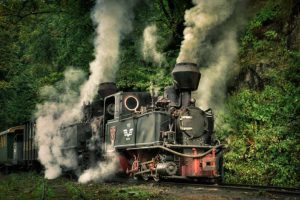McGregor & Partners are representing the SARUK (Sibiu Agnita Railway-UK), a British organisation which supports the Romanian NGO “Asociația Prietenii Mocăniței” in their efforts to preserve and restore to use the narrow-gauge railway between Sibiu and Agnita and Vurpăr, which is a national monument.
At the end of XIXth century, it was decided to link the city of Sibiu with Sighișoara through 109 km of railway with a narrow gauge of 760 mm (the standard gauge being of 1435 mm), to transport local people and agricultural and forest products. The line between Sighişoara and Agnita was closed and dismantled in 1965 and the last train ran between Agnita and Sibiu in September 2001, being the last narrow-gauge railway operated by CFR.
The line was closed but not forgotten, because in 2009 The line was closed but not forgotten, because in 2009 Asociația Prietenii Mocăniței was formed as a Romanian non-governmental organisation with the objective to preserve and gradually restore this narrow-gauge railway. Creating a touristic train on the rails of the Mocănița will help local people, contribute to attracting tourists to the Hârtibaciu valley and the sustainable development of this area of Romania. “Asociația Prietenii Mocăniței” was formed as a Romanian non-governmental organisation with the objective to preserve and gradually restore this narrow-gauge railway. Creating a touristic train on the rails of the Mocănița will help local people, contribute to attracting tourists to the Hârtibaciu valley and the sustainable development of this area of Romania.
Voluntary societies to preserve similar historic narrow-gauge railways began in the UK in the early 1950s and there is now a well-established and successful sector of heritage railways in the UK. Whilst they have small core teams of employees, they are supported and depend upon the assistance of volunteers for their operation and development. Studies have found that they make a large contribution to the prosperity of the areas in which they operate.
A group of British people who are involved in various heritage railways in the UK decided to lend a hand to the efforts of the “Asociația Prietenii Mocăniței” and founded a support group (SARUK, Sibiu Agnita Railway-UK), including by raising funds and by providing expert practical assistance. The British supporters have visited the line many times and shown how to repair the track and bridges. They include Neil McGregor, the managing partner of McGregor & Partners, who has more than thirty years of experience of practical work on a major heritage railway in the UK in his holidays and spare time.
Until now, the volunteers have succeeded to rehabilitate nine kilometres of railway, to build a carriage shed at Agnita and to restore the buildings of Coveş, the water tower from the Cornăţel canton and the stable of Alţîna railway station. They have also restored a carriage, have built a moto-trolley and two cycle-trolleys used for pleasure rides in the line. Tourists are very excited by the trolleys with wooden benches, which can transport 16 people at a speed of nearly 40 km/h, and the funds raised help acquire the necessary tools and materials.
The project has received from publicity in the UK media and benefits from the support of the British ambassador and the European Federation of Railway Preservation Associations (Fedecrail).
Beyond the physical labour on the line, legal efforts are also required for the project to be successful. In addition to his practical work on railway tracks, Neil McGregor is the company secretary of the Nene Valley Railway, a major heritage railway in the UK, and McGregor & Partners have been instructed to clarify the legal status of the Sibiu – Agnita Railway and the steps that will be required for it to become an operational heritage railway, attracting tourists to the Hârtibaciu valley.
“This is a very challenging project, given that the Sibiu – Agnita “mocănița” is not only subject to the general Romanian legal framework for railways, but is also a Romanian national monument. I think that it is probably also fair to say that the future of lines such as this was not a priority when the former single CFR organisation was divided into different companies and entities and also that the model of volunteer-led, community-based heritage railways is not familiar in Romania, although it is well-established and successful in the UK.
, explains Neil McGregor.
Although the Sibiu – Agnita Railway is a national monument and could be operated as a heritage line for the benefit of people, businesses and civil society in Sibiu County, the fact that it is in substantial danger has recently been highlighted by the recent purported lease by one of the successor entities of CFR of the line’s depot for use as a car workshop. Timely intervention and the assistance of the County cultural authorities appears to have prevented irreversible damage being done to this part of the national monument, but it makes it plain that there needs to be a viable framework for the line to have a sustainable and useful future.
We are very encouraged by the support that exists, both in Romania and elsewhere, for the preservation and re-opening of this very attractive line. My team and I will use all necessary efforts to help this important project of civil society to succeed, so that the Mocăniţa is given back to the inhabitants of and visitors to the Hârtibaciu valley.”
A first target is to hold a gala at Cornațel station on 26 and 27 September, in the presence of the British Ambassador and other dignitaries. This will see a steam locomotive and passenger trains along the line towards Hosman. Having been one of the British team which worked on the track in June, Neil will be back at Cornațel for the gala, to continue the practical – and the legal – work on this project.
“This project is a very special one for my team and I, not only because it involves complex legal challenges but also because it involves a number of causes which are close to my heart: railways, developing civil society organisations, preserving Romania’s national heritage and enjoying physical exercise in the beautiful countryside of Transylvania. What an ideal way to combine Romanian and British enthusiasm and expertise!”
concludes Neil McGregor.





